 I’ve met Paolo Rigamonti and Silvio Mondino from Limiteazero here and there: at their studio, at the Ars Electronica festival in Linz and more recently at Hublab in Milan. The Hublab gallery is brand new and its mission is to show off the best of young Italian talents. The gallery’s first exhibition is dedicated to the Milan-based architecture + media design + media art practice. Yes that makes three disciplines. The duo doesn’t believe anymore in the necessity (or rather the relevance) to hermetically divide those areas. Paolo has been trained as an architect and Silvio has a background in electronic music. And although they’ve started collaborating with people like Tomato, they just teach themselves the other skills they need whenever they are working on a new project.
I’ve met Paolo Rigamonti and Silvio Mondino from Limiteazero here and there: at their studio, at the Ars Electronica festival in Linz and more recently at Hublab in Milan. The Hublab gallery is brand new and its mission is to show off the best of young Italian talents. The gallery’s first exhibition is dedicated to the Milan-based architecture + media design + media art practice. Yes that makes three disciplines. The duo doesn’t believe anymore in the necessity (or rather the relevance) to hermetically divide those areas. Paolo has been trained as an architect and Silvio has a background in electronic music. And although they’ve started collaborating with people like Tomato, they just teach themselves the other skills they need whenever they are working on a new project.
So back to Hublab, their choice to dedicate their space to new media art (or whatever you want to call it) installations is very brave. You don’t see such initiative everyday in Italy (nor in many other countries for that matter.) You’ve heard it before: nma installations are good fun but unwieldy, they require constant maintenance, one can never count on technological parts to function 24/7, nma doesn’t appeal to the broad public, etc. Limiteazero’s works, however, approach aesthetic perfection, whether you understand what lies behind or not. They are beautiful objects you could watch for hours. Even the way Limiteazero exposes the inside of electronic devices is smooth and polished.
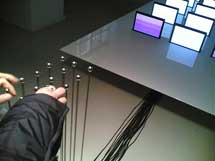
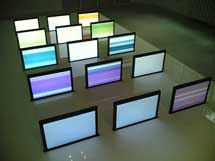
The work that first attracted my attention in the gallery was Laptop Orchestra, a synaesthetic instrument to perform audio visual compositions in real time. Fifteen laptops are arranged like an orchestral group. On each one is installed a Processing Software consisting in algorithms which activate sounds and visual shapes based on color spectrum. Each laptop has its own sound and its own instructions for the construction of a shape.
Interacting from the conductor podium, just by slightly touching metal stems, you can activate or deactivate each single laptop, permitting the generation of an endless number of different compositions.
The work had been commissioned by Toshiba in 2004. At the time the Milan duo had also developed a very different work using the same laptops. While Laptop Orchestra is very visual and plays on the laptop as a design “product” that is turned into a kind of very simple switch, min_mod [minimum_module] plays with frequencies, vibrations and space.
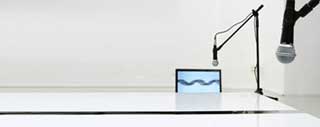 4 pure frequencies with sinusoidal course are generated by a software installed on 4 laptops. Each laptop transmits the digital sound data to an amplifier which in turn transmits the sound to 4 subwoofer positioned on the floor. On each one of them is positioned a metal plate which amplifies and makes the subwoofer vibrations perceptible. 4 microphones retransmit the sound back to the laptop which visualises its wave shape on the screen.
4 pure frequencies with sinusoidal course are generated by a software installed on 4 laptops. Each laptop transmits the digital sound data to an amplifier which in turn transmits the sound to 4 subwoofer positioned on the floor. On each one of them is positioned a metal plate which amplifies and makes the subwoofer vibrations perceptible. 4 microphones retransmit the sound back to the laptop which visualises its wave shape on the screen.
The installation traces a junction line within the digital dimension in which the sound is generated and its physical impact, identified in the phenomenon of the vibration.
At the heart of Active Metaphore is Carnivore. Developed by the Radical Software Group, Carnivore is inspired by a piece of software used by the FBI to monitor the Internet communications of suspects under its surveillance. The RSG software application listens to all Internet traffic on a specific local network and then feeds this to a series of artist-made interfaces—called “Carnivore Clients”—for visualization and animation. Golden Nica in 2002 at Ars Electronica and an honorable mention at read_me 1.2.
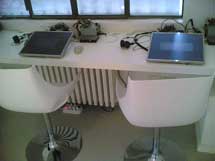
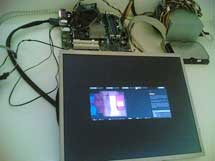
The data used in Active Metaphore is the ip address, the main data that identifies an internet relationship. The ip address (“aaa.bbb.ccc.ddd”) is broken down into four different groups of numbers (“aaa”, “bbb”,”ccc”, “ddd”). These elements are used as coordinates for 3D shapes and blending percentages (“x”, “y”, “z”, “blend”).
The work lets us see and hear the data flow, which is something that we normally can’t perceive. This lets us see the net as a huge data field that is constantly moving, like a digital life-form that feeds itself with human interaction.
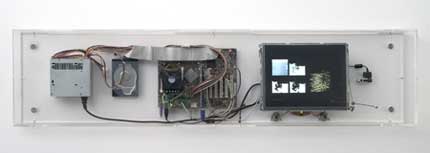 The Remains of You is made of a computer assembled in a transparent box, a USB camera and one proximity sensor.
The Remains of You is made of a computer assembled in a transparent box, a USB camera and one proximity sensor.
When somebody skims over the steel stick on the front side, it freezes the scene and starts an image subtractive synthesis process till the most elementary shape obtainable by the mix of light and shade. Then, a 3D model of the last step of the synthesis comes to be built, giving the feeling to turn back to a 3D space dimension even if it has been worked out from the most elementary part of the two dimensions captured image.
Other works featured in the exhibition: bb_write and a_mirror.
See 0006_Limiteazero at Hublab Gallery, Via Vigevano 43, Milano (entrance from via Sartirana) until April 10th 2006.
Meet them at Wired NextFest 06, September 28, October 1.
